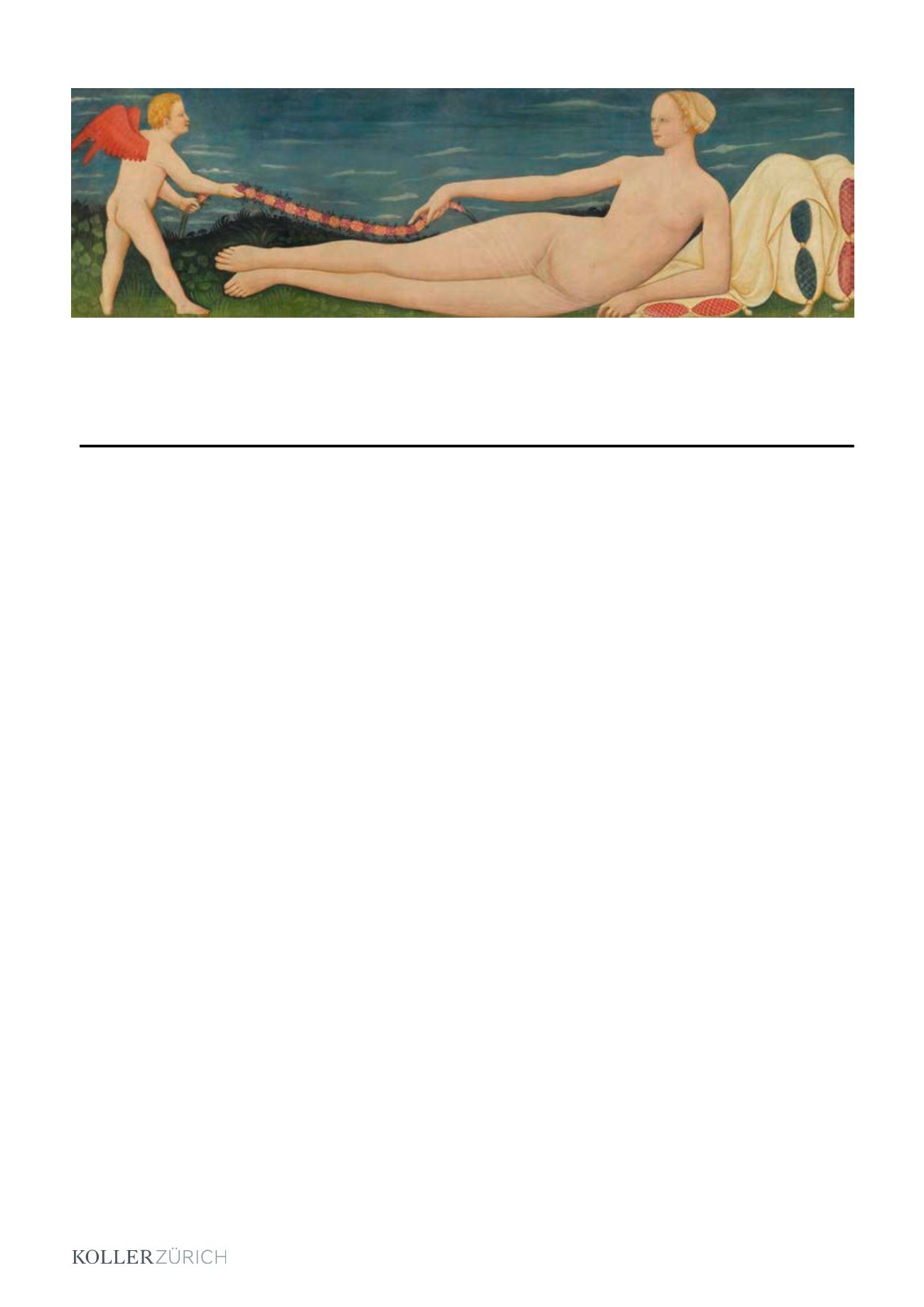

BADALONI, PAOLO DI STEFANO known
as PAOLO SCHIAVO
(Florence 1397 - 1478 Pisa)
Venus and Cupid. ca. 1440-45.
Tempera on wood.
50.8 x 170 cm.
Provenence:
- Collection of L. Grassi, Florence, ca. 1971.
- Collection of J. Paul Getty Museum, Malibu,
1972-1992, inv. no. 72.PB.9 (label verso).
- Auction Christie’s, New York, 21.5.1992.
- Museo Privato Bellini, Florence (label verso
“Mr. Luigi Bellini”).
- European private collection.
Exhibitions:
- Art and Love in Renaissance Italy, Metropo-
litan Museum of Art, New York, 11.11.2008-
16.2.2009, no. 58b (label verso).
- Doni d’amore. Donne e rituali nel Rinasci-
mento, Pinacoteca cantonale Giovanni Züst,
Rancate (Mendrisio, Switzerland), 12.10.2014-
11.1.2015, no. 31.
Literature:
- Callmann, Ellen: Un Apollonio di Giovanni
per cassone nuziale, in: Burlington Magazine,
no. 888, Vol. CXLX, March 1977, p. 178.
- Boskovits, Miklos: Ancora su Paolo Schiavo.
Una scheda biografica, in: Arte Cristiana, 1995,
no. 770, pp. 332-340.
- Bayer, Andre / Cartwright, Sarah: Art and
Love in Renaissance Italy, Metropolitan
Museum of Art, New York 2009, no. 58b, pp.
134-136.
- Lurati, Patricia: Doni d‘amore. Donne e rituali
nel Rinascimento, Pinacoteca cantonale Gio-
vanni Züst, Rancate (Mendrisio), 12.10.2014-
11.1.2015, no. 31, pp. 100-101.
This rare and magnificent panel with the
elongated figure of Venus and the winged Cupid
in a landscape, holding a band of flowers, was
once owned by the J. Paul Getty Museum in
Los Angeles and was last seen by the public on
the occasion of the major exhibition “Art and
Love in Renaissance Italy” at the Metropolitan
Museum of Art, New York, in 2008/2009. Now,
after a long time in private hands, this remarka-
ble work has arrived on the market once again.
It can be dated to the period ca. 1440-45, at the
beginning of the Italian Renaissance, and served
once as the interior of a wedding chest (cassoni),
of which only a few are preserved today.
Cassoni, in which the bride brought her personal
belongings into married life, were not only
treasured pieces of furniture for the storage of
valuable clothes and textiles during the Renais-
sance, but also functioned as important prestige
items in domestic spaces. They had a symbo-
lic character as well, for they were meant to
serve an auspicious function and guarantee the
fruitfulness of a marriage. The painted interiors
of the covers played an important role because
they were revealed only to their owners in priva-
te, when the chests were opened, and reflected
the widespread belief that beautiful images had
an influence on the feelings of the bride and
her unborn children (see Gombrich, Ernst H.:
Apollonio di Giovanni. A Florentine Cassone
Workshop Seen through the Eyes of a Humanist
Poet, in: Journal of the Warburg and Courtauld
Institute 18, nos. 1-2, January-June 1955, p. 27).
Accordingly, motifs were chosen that alluded to
the love and fecundity of the married couple,
such as putti and amoretti, as well as lightly
clad or nude elongated male and female figures,
as the painting offered here demonstrates very
clearly.
Our panel shows Venus lightly clad in a
transparent veil before a deep-blue band of sky
dotted with clouds. Venus is supported by three
fabric-covered cushions and grasps the end of
a flower garland, which is held at the other end
by winged Cupid and resembles a marriage belt.
Similar pillows, so-called “intimelle”, are also
found in a miniature by Apollonio di Giovanni
(1415-1465) (see Thornton, Peter: The Italian
Renaissance Interior 1400-1600, New York 1991,
p. 195, ill. 219), and suggest a reference to do-
mesticity, in contrast to the pastoral background
of the scenery. Both the design and the long,
narrow form of the wooden panel evidence its
original function as the inner-lid of a marriage
chest.
Our panel can be compared thematically with
the interiors of two cassoni by Giovanni di
Ser Giovanni Guidi, known as Lo Scheggia
(1406-1486), which are found today in the
National Gallery of Art, Copenhagen (inv. nos.
KMS4785 and KMS4786) and thematize as well
a comparable elongated nude figure each (fig. 1).
In 1971 Federico Zeri researched the painting
offered here and associated it with a panel today
in the Springfield Museum of Fine Arts, which
depicts the story of Callisto (see Springfield,
MA, Museum of Fine Arts, Manuale delle
Collezioni Americane ed Europee, 1979, p. 117,
no. 202). He suggested that these two panels
embellished the same chest. The attribution to
Paolo Schiavo was moreover confirmed by Prof.
Everett Fahy when the painting was sold from
the collection of the J. Paul Getty Museum.
The painter Paolo di Stefano Badaloni, known
as Paolo Schiavo, was a versatile and variously
proficient Renaissance master, who was admit-
ted to the Florentine painters’ guild in 1429 and,
in addition to altarpieces, frescoes and cassoni,
created numerous book illustrations and prepa-
ratory drawings for tapestries and stained-glass
windows.
The painting is in the archive of the Fondazi-
one Zeri, registered under the no. 11839 as an
autograph work by Paolo Badaloni, known as
Paolo Schiavo.
CHF 250 000 / 350 000
(€ 231 500 / 324 100)
AUSKLAPPER
3013
| 21
















